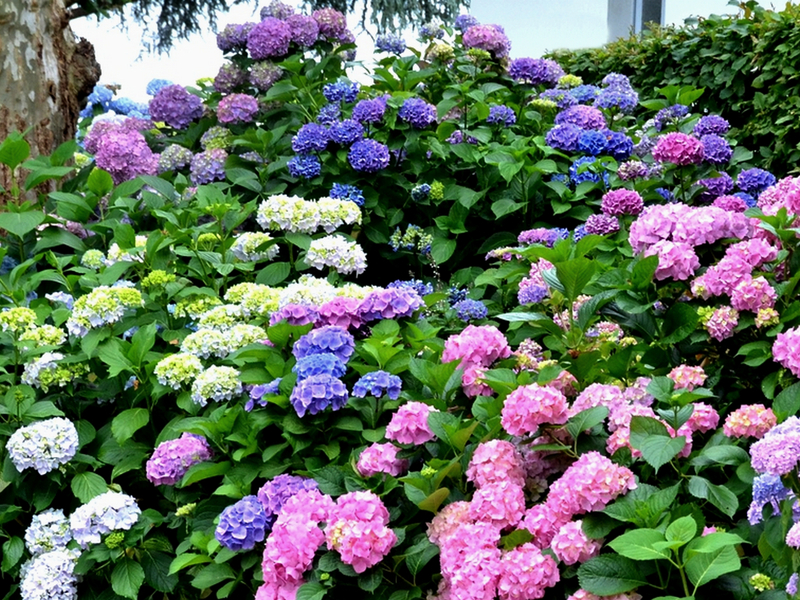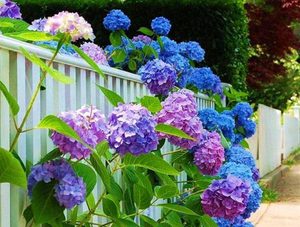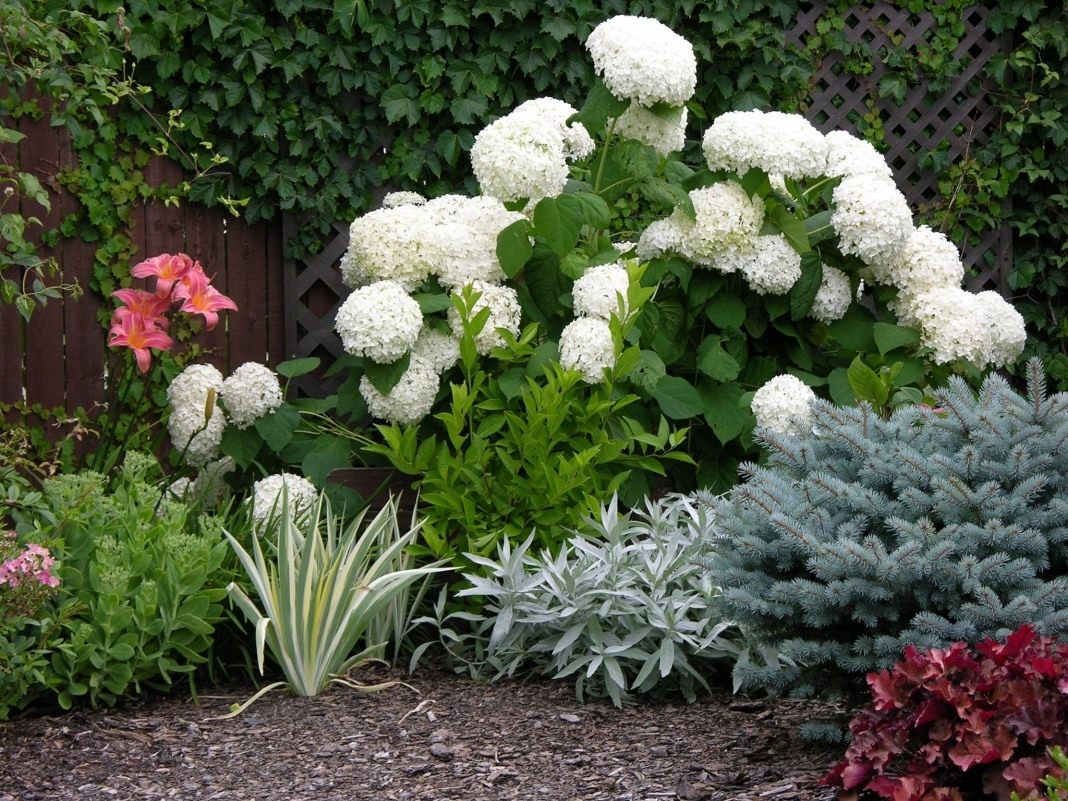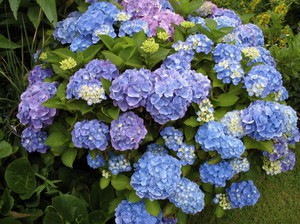 Hydrangea is a species of flowering plants of the Hortensia group. According to various sources, the genus of these flowers numbers 40-70 varieties, their habitat is Asia, America, with the largest variety of species in Japan and China. A number of species can be found in the Far East.
Hydrangea is a species of flowering plants of the Hortensia group. According to various sources, the genus of these flowers numbers 40-70 varieties, their habitat is Asia, America, with the largest variety of species in Japan and China. A number of species can be found in the Far East.
Content
Description of Hydrangeas (Hydrangea macrophylla)
For the first time in Europe this flower was brought from China in 1821... The selection of hydrangeas began in 1905. As a rule, these were species that were obtained from varieties of garden and large-leaved hydrangea that were weakly resistant to frost. Therefore, in the beginning, this plant was grown only as an indoor flower.
By the 70s of the 20th century, about 120 hybrids were bred. The main number of species are considered shrubs up to 3 m in size, some varieties are small trees, the rest are vines that can grow up to 35 m. Trees are either deciduous or evergreen, but the most cultivated species in temperate regions are deciduous.
These plants bloom from early spring to late autumn. The inflorescences are at the end of the stem in beautiful spherical buds. In many varieties, flower heads have two types of inflorescences: small, fertile inflorescences in the center and large sterile inflorescences at the edges. In some varieties, all inflorescences are fertile and are the same size.
Most of the flowers are white, but some, for example, the hydrangea is large-leaved, they are blue, purple, yellow, red, etc. In these species, the color often depends on the acidity of the soil pH: in an acidic soil, the petals become blue, in a neutral soil - beige, and in an alkaline soil - red. Hydrangeas can accumulate aluminum from acidic soil, and some varieties form compounds that give them a blue color.
Hydrangeas are hardy and unpretentious decorative flowers with a beautiful color and a long flowering time of hemispherical inflorescences. For successful flowering, you must follow two main rules:
- Constantly wet ground;
- The temperature in winter is at least 7C.
Varieties of hydrangea
 Large-leaved hydrangea... The homeland of this flower is Japan and China. A wonderful ornamental bush. In the tropics it can reach a height of up to 3.5 m, in the northern regions up to 1.5 m. The leaves are ovoid, bright green in color. Infertile inflorescences are large in size, red, with carmine blotches up to 4 cm in diameter, fertile purple, less often blue, in flat shields (12x16 cm). In garden varieties, flowers are spherical, up to 22-26 cm in diameter, located at the ends of the shoots.
Large-leaved hydrangea... The homeland of this flower is Japan and China. A wonderful ornamental bush. In the tropics it can reach a height of up to 3.5 m, in the northern regions up to 1.5 m. The leaves are ovoid, bright green in color. Infertile inflorescences are large in size, red, with carmine blotches up to 4 cm in diameter, fertile purple, less often blue, in flat shields (12x16 cm). In garden varieties, flowers are spherical, up to 22-26 cm in diameter, located at the ends of the shoots.
Japanese large-leaved hydrangea... A bush with flat flowers, where there are large sterile flowers at the edges and fertile flowers in the center. Bushes with corymbose inflorescences look quite elegant.
Large-leaved hydrangea cultivar magical amethyst. Quite an original type of plant. The flowers change color all the time - at first they are lemon green, then they acquire a pink tint and then get a green edging. Many small flowers create large, almost spherical inflorescences.Bushes are small, about 80-130 cm, 50-80 cm in diameter. Perfect for vases, as well as dried flowers.
Large-leaved hydrangea cultivar magical coral. Also a bright representative of large-leaved plants of varieties "magical", similar in appearance to the above-described species. The flowers are also lemon green at first, then pink with purple edging. The bloom is quite lush, in June-September. The flowers are in large inflorescences up to 25 cm in size, well suited for cutting. The plant is up to 110-130 cm in size, 110 cm in diameter. It is advisable to choose a semi-shady plot for growing. The soil is sour, with excellent drainage. In winter, it needs shelter.
Petiolate hydrangea... It has small leaves, glossy, bright green. The stems are elastic, due to the presence of air roots, they can climb walls, trees, etc. The flowers are pale green, located in the scutes. It grows slowly in the first season.
Treelike hydrangea. Has white flowers. Blooms in June-September. At the end of autumn, it is advisable to cut off the faded flowers. Pruning weak shoots must be done either before sap flow, or after full blooming of the leaves.
Hortense Bretschneider. Originally from China. Large shrub up to 2.5 m in size. The leaves are oval and large, bright green. Begins flowering in late June. First, the flowers are white, by the beginning of August they turn pink, and in September they get a bright crimson color.
Hydrangea paniculata... The bush is about 1.5 m high. Green inflorescences are formed in early June, whiten by July. This plant is highly resistant to pores. In the fall, pruning of wilted flowers is required, in the spring - formative pruning.
Hydrangea is oak-leaved. View from South America. The bush is about 1 m in size. The leaves are similar to oak, bright green above, below - with white fluff. Flowers - similar to a paniculate species, but more oblong, with small sterile flowers, in autumn they get a crimson color. In our country, the bush often freezes over.
Hortense Sargent. A variety from China. In our conditions, this species is most often grown as a perennial plant, since this variety freezes out almost every year.
Growing and care
Shine
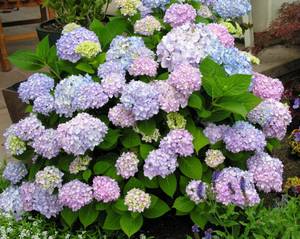 This plant prefers partial shade, the bush does not like direct sunlight. Suitable for planting on windowsills in the east and west. It can be planted on the northern windowsill, but due to lack of lighting it stretches out and does not bloom so actively. When a bush is found near windows in a southern direction, you need to install a plant a short distance from the windowshading from direct sunlight. In summer, it is advisable to take the container with the plant outside and install in the shade.
This plant prefers partial shade, the bush does not like direct sunlight. Suitable for planting on windowsills in the east and west. It can be planted on the northern windowsill, but due to lack of lighting it stretches out and does not bloom so actively. When a bush is found near windows in a southern direction, you need to install a plant a short distance from the windowshading from direct sunlight. In summer, it is advisable to take the container with the plant outside and install in the shade.
If during the growing season the plant cannot be placed in the sun, then in winter, from the beginning of January (the time of the appearance of buds), it is advisable to install the bush in the most illuminated areas.
Temperature
This plant requires maintenance at a temperature of 17-23C in the warm season. The bush winters well on a window where there is no heating battery (the temperature during this period can fluctuate in the range of 7-13C).
Watering
Abundant watering is required from spring to autumn, according to the degree of drying of the top layer of the soil, and then reduce it over time. In winter, the bush is rarely watered - according to the degree of soil drying, but so that the soil does not dry out. Watering is done more abundantly during the appearance of leaves, as a rule, this is January, and with the appearance of buds, the bush is fed with complex additives.
Growing features
The bush has a pronounced dormant time in winter. At this time, the plant sheds foliage and goes into dormancy for 2 months. Store them in dry, cool basements or near cool windows.
Pruning
In the springtime, it is necessary to prune the bush in order to align it and remove the stems that are very weak for bud formation.In addition, it will promote excellent shoot growth, increased flowering and larger buds. Pruning must be carried out deeply, leaving 3-6 eyes on the branches.
Humidity
These plants prefer high air humidity... To maintain the necessary moisture throughout the year, the bushes need to be sprayed. You can install flower pots on pallets with moistened peat or expanded clay. Moreover, the bottom of the pot should not come into contact with water.
Fertilizer
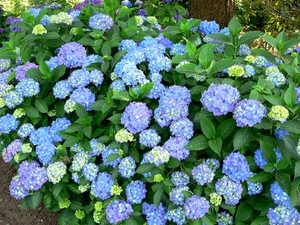 With the appearance of buds, the bush is fed with complex additives. During the growing season, the plants need to be thoroughly fed weekly; during rest, no additives are used. The feeding recommendations are as follows:
With the appearance of buds, the bush is fed with complex additives. During the growing season, the plants need to be thoroughly fed weekly; during rest, no additives are used. The feeding recommendations are as follows:
- bushes with pink inflorescences - liquid mineral fertilizer;
- with blue - additives for heather.
In order to create lush flowering on old plants, in the spring you need to use mineral and organic additives, preferably in liquid form.
Transfer
Transplanting bushes must be done annually. After flowering, you need to remove the old inflorescences, cut off the shoots by half the size and transplant the bush into a new soil composition. During transplanting in the spring you need observe the following rules:
- for red, pink and white species, a low acid soil is chosen;
- blue species are transplanted into soil with high acidity.
Priming
A primer for these flowers is required with a high acidity (pH 6). For flowers with blue inflorescences, it is advisable to choose a pH of 3-4. You can choose peat, coniferous, turf soil and sand in a ratio of 1: 2: 1: 0.5 or ready-made soil for azaleas. Humus soil is not used during cultivation, since it causes chlorosis of the plant.
Reproduction
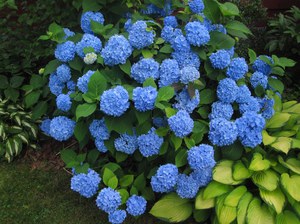 As a rule, the Hydrangea macrophylla bush is propagated by cuttings. For indoor propagation, you can choose both adult bushes and surface cuttings. For cuttings in the spring, young shoots are used from below with leaves 5-7 cm in size. They are planted with a distance of 5-6 cm between themselves in deep containers, burying 2-3 cm into the ground, and covered with glass. After 2 weeks, they are transplanted into pots. Cut off the tops in Juneso that the flowers grow bushy. Cutted in June, the bushes will bloom in July next year. One-year-old bushes have 2-4 inflorescences.
As a rule, the Hydrangea macrophylla bush is propagated by cuttings. For indoor propagation, you can choose both adult bushes and surface cuttings. For cuttings in the spring, young shoots are used from below with leaves 5-7 cm in size. They are planted with a distance of 5-6 cm between themselves in deep containers, burying 2-3 cm into the ground, and covered with glass. After 2 weeks, they are transplanted into pots. Cut off the tops in Juneso that the flowers grow bushy. Cutted in June, the bushes will bloom in July next year. One-year-old bushes have 2-4 inflorescences.
Small side shoots and root shoots should be removed, leaving a few of the strongest shoots for future flowering - flowers appear only on last year's mature stems. The bush also propagates with the help of seeds, sometimes by separation or by offspring.
Security measures
The foliage of large-leaved hydrangea is very poisonous and can cause dermatitis.
Possible difficulties
Plants are exposed to chlorosis - as a rule, this comes from humus earth and lime water. With excessive light, bright spots form on the leaves. With low watering and insufficient moisture, the tips of the leaves dry out.
Beneficial features
The name “Hydrangea macrophylla” itself means “water vessel” and reflects the plant's love for water, as well as the positive effect on the human person - it improves salt metabolism.
Treelike hydrangea has favorable properties. The root of the hydrangea flower has long been used medicinally during inflammation of the urinary organs. Its extract has a mild diuretic and healing effect, which has a cleansing effect on the genitourinary organs, removes harmful substances from the body, and reduces swelling.
The active elements of the plant help to remove uric acid from the body, prevent the accumulation of stones and sand in the urinary tract, have antimicrobial effects.
The leaves of the flower remove spasms in the urinary canals, create an analgesic effect. The root is used to ease the menstrual cycle. The bush has proven itself excellently as an additional remedy for the relief of prostate diseases.It also creates a tonic effect on the kidneys, improves their work.
Hydrangea is used for:
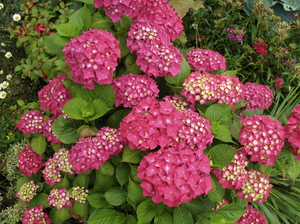 pyelonephritis;
pyelonephritis;- cholelithiasis;
- cystitis;
- kidney stones;
- inflammation of the reproductive system;
- joint pain;
- diseases of the prostate gland;
- obesity and edema.
Hydrangeas are shrubs of splendid beauty and variety. In ornamental cultivation, they are valued for the variety of flower species, a wide range of colors, interesting bark, and lush flowering and unpretentiousness... The flowers are most spectacular in autumn, when leaves of different colors, heads with seeds and buds can be simultaneously seen on the same bush.
